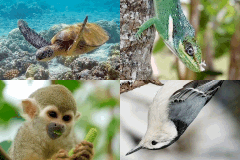AnAge entry for Arctica islandica
Arctica islandica is a species with negligible senescence
Classification (HAGRID: 04235)
- Taxonomy
-
Kingdom: Animalia
Phylum: Mollusca
Class: Bivalvia (Taxon entry)
Order: Veneroida
Family: Arcticidae
Genus: Arctica
- Species
- Arctica islandica
- Common name
- Ocean quahog clam
- Synonyms
- Cyprina islandica
Lifespan, ageing, and relevant traits
- IMR
- Not yet available
- MRDT
- No MRDT detected
- Maximum longevity
- 507 years (wild)
- Source
- ref. 1086
- Sample size
- Medium
- Data quality
- Acceptable
- Observations
The ocean quahog clam shows exceptional longevity. One specimen called "Ming" was estimated to live up to 507 years in the wild [1086]. One study found that in animals aged 4-192 years, antioxidant enzymes declined rapidly in the first 25 years, which includes the growth and sexual maturity stages, but afterwards remained stable for over 150 years [0829]. In addition, the level of oxidatively damaged proteins in the heart does not change significantly up to 120 years of age [1162].
The ocean quahog clam has very high proteome stability, especially in comparison to short-lived mammals. In one study it was demonstrated these animals had no increase in global proteome unfolding in response to several stressors [1163]. The extreme maximum lifespan of the ocean quahog clam appears to be independent of telomere dynamics. Telomere lengths show no change with age, with no significant differences between populations and tissues. Telomerase activity is also highly heterogenous and does not correlate with age or population habitat [1164]. A study that measured four age-related damage markers (protein oxidation, lipid oxidation, nucleic acid oxidation, and protein stability) reported that only nucleic acid oxidation accumulates with age in these animals [1165]. Though more detailed studies are warranted, it appears this species is a case of negligible senescence.
Life history traits (averages)
- No information is available on life history. Please contact us if you wish to suggest or contribute data.
Metabolism
No information on metabolism is available.
References
- [1226] Treaster et al. (2015), Longevity and GAPDH Stability in Bivalves and Mammals: A Convenient Marker for Comparative Gerontology and Proteostasis (PubMed)
- [1165] Gruber et al. (2015), Age-related cellular changes in the long-lived bivalve A. islandica (PubMed)
- [1164] Gruber et al. (2014), Telomere-independent ageing in the longest-lived non-colonial animal, Arctica islandica (PubMed)
- [1162] Sosnowska et al. (2014), A heart that beats for 500 years: age-related changes in cardiac proteasome activity, oxidative protein damage and expression of heat shock proteins, inflammatory factors, and mitochondrial complexes in Arctica islandica, the longest-living noncolonial an (PubMed)
- [1163] Treaster et al. (2014), Superior proteome stability in the longest lived animal (PubMed)
- [1095] Ungvari et al. (2013), Resistance to genotoxic stresses in Arctica islandica, the longest living noncolonial animal: is extreme longevity associated with a multistress resistance phenotype? (PubMed)
- [1086] Butler et al. (2013), Variability of marine climate on the North Icelandic Shelf in a 1357-year proxy archived based on growth increments in the bivalve Arctica islandica
- [1098] Philipp et al. (2012), Gene expression and physiological changes of different populations of the long-lived bivalve Arctica islandica under low oxygen conditions (PubMed)
- [1085] Munro and Blier (2012), The extreme longevity of Arctica islandica is associated with increased peroxidation resistance in mitochondrial membranes (PubMed)
- [0893] Ungvari et al. (2011), Extreme longevity is associated with increased resistance to oxidative stress in Arctica islandica, the longest-living non-colonial animal (PubMed)
- [0829] Abele et al. (2008), Imperceptible senescence: Ageing in the ocean quahog Arctica islandica (PubMed)
- [0014] Leonard Hayflick (1994), How and Why We Age
- [0002] Caleb Finch (1990), Longevity, Senescence, and the Genome
- [0593] MarLIN - Marine Life Information Network
External Resources
- Integrated Taxonomic Information System
- ITIS 81343
- Animal Diversity Web
- ADW account (if available)
- Encyclopaedia of Life
- Search EOL
- NCBI Taxonomy
- Taxonomy ID 59239
- Entrez
- Search all databases
- Ageing Literature
- Search Google Scholar or Search PubMed
- Images
- Google Image search
- Internet
- Search Google

